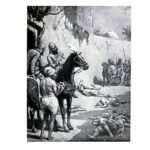
Many adherents of Buddhism have experienced religious persecution TV.
Many adherents of Buddhism have experienced religious persecution because of their adherence to the Buddhist practice, including unwarranted arrests, imprisonment, beating, torture, and/or execution. The term also may be used in reference to the confiscation or destruction of property, temples, monasteries, centers of learning, meditation centers, historical sites, or the incitement of hatred towards Buddhists.
Sassanids
In 224 CE Zoroastrianism was made the official religion of Persia, and other religions were not tolerated, thus halting the spread of Buddhism westwards. In the 3rd century the Sassanids overran the Bactrian region, overthrowing Kushan rule, were persecuted[clarification needed] with many of their stupas fired. Although strong supporters of Zoroastrianism, the Sassanids tolerated Buddhism and allowed the construction of more Buddhist monasteries. It was during their rule that the Lokottaravada followers erected the two Buddha statues at Bamiyan.
During the second half of the third century, the Zoroastrian high priest Kirder dominated the religious policy of the state. He ordered the destruction of several Buddhist monasteries in Afghanistan, since the amalgam of Buddhism and Zoroastrianism manifested in the form of a “Buddha-Mazda” deity appeared to him as heresy. Buddhism quickly recovered after his death.
Pushyamitra Shunga
The first persecution of Buddhists in India took place in the 2nd century BC by King Pushyamitra Shunga. A non-contemporary Buddhist text states that Pushyamitra cruelly persecuted Buddhists. While some scholars believe he did persecute Buddhists based on the Buddhist accounts, others consider them biased because of him not patronising them.
Many other scholars have expressed skepticism about the Buddhist claims. Étienne Lamotte points out that the Buddhist legends are not consistent about the location of Pushyamitra’s anti-Buddhist campaign and his death: “To judge from the documents, Pushyamitra must be acquitted through lack of proof.” Agreeing with him, D. Devahuti states that Pushyamitra’s sudden destruction after offering rewards for Buddhist heads is “manifestly false”. R. C. Mitra states that “The tales of persecution by Pushyamitra as recorded in Divyavadana and by Taranatha bear marks of evident absurdity.”
Hepthalites.
Central Asian and North Western Indian Buddhism weakened in the 6th century following the White Hun invasion who followed their own religions such as Tengri and Manichaeism. Around 440 CE they conquered Sogdiana then conquered Gandhara and pushed on into the Gangetic Plains. Their King Mihirkula who ruled from 515 CE suppressed Buddhism, destroying monasteries as far as modern-day Allahabad before his son reversed the policy.
Pandyas and Pallavas
There is no citation for the below story. Scholars like Paul Dundas have also called it a ‘mythical story’
After the Kalabhra interregnum, the Tamil states of the Pandyas and Pallavas reemerged, reviving the Saivite and Vaishnavite native religions. Further, the Saivite saint Thirugnanasambandar theologically defeated 8000 Sramanas with Buddhist names among them. When they rebelled, they were impaled by Koon Pandiyan at Samanatham near Madurai.
Mahendravarma Pallava under Appar, a reformed Saivite saint destroyed Sramana monuments and wrote Mattavilasaprahasana, a comic play on the heretical (non Vedic) sects of the time including Buddhism. These events are considered to be the ushering in of the Bhakti era in India which resulted in the routing of Buddhism in the India.










Leave a Reply